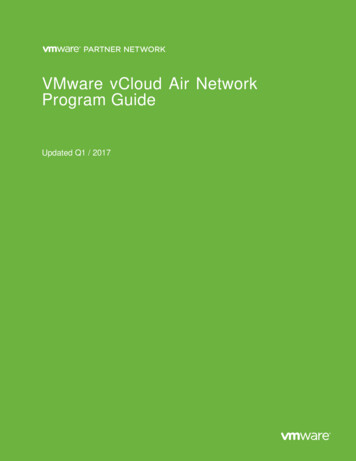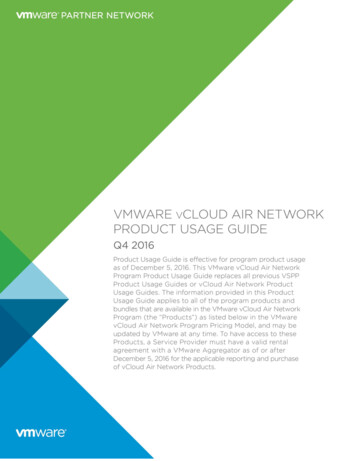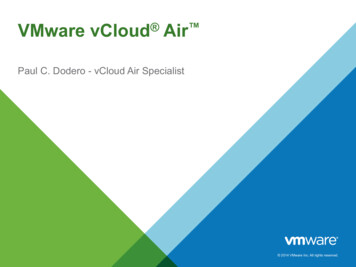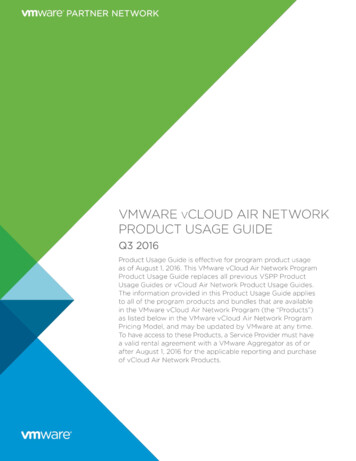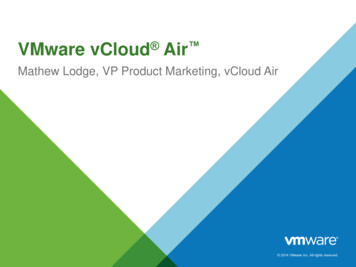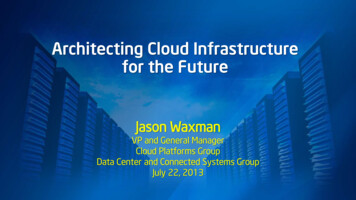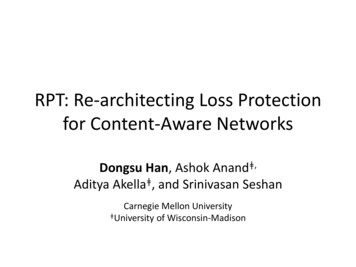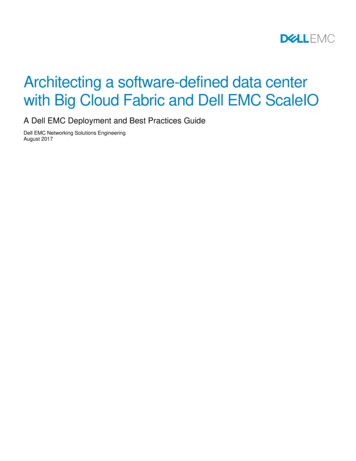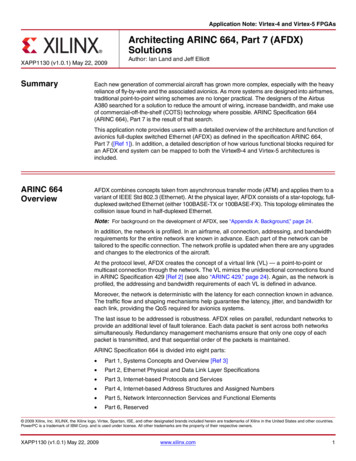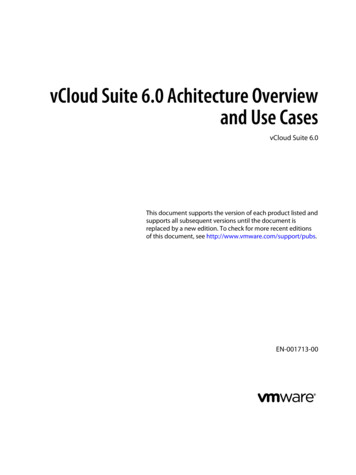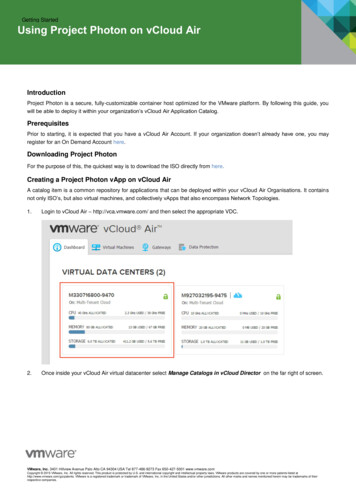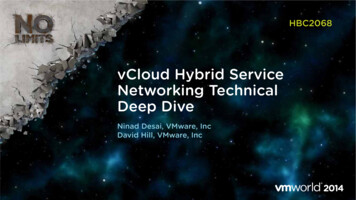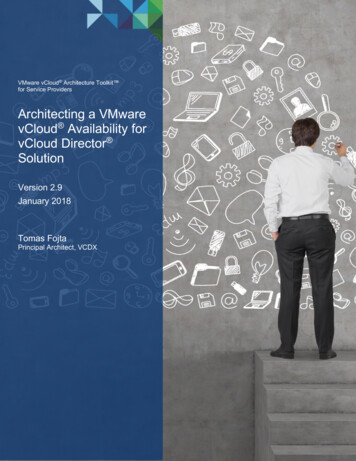
Transcription
VMware vCloud Architecture Toolkit for Service ProvidersArchitecting a VMwarevCloud Availability forvCloud Director SolutionVersion 2.9January 2018Tomas FojtaPrincipal Architect, VCDX1 VMware vCloud Architecture Toolkit for Service Providers
Architecting a VMware vCloud Availability for vCloud Director Solution 2018 VMware, Inc. All rights reserved. This product is protected by U.S. and international copyright andintellectual property laws. This product is covered by one or more patents listed re is a registered trademark or trademark of VMware, Inc. in the United States and/or otherjurisdictions. All other marks and names mentioned herein may be trademarks of their respectivecompanies.VMware, Inc.3401 Hillview AvePalo Alto, CA 94304www.vmware.com2 VMware vCloud Architecture Toolkit for Service Providers
Architecting a VMware vCloud Availability for vCloud Director SolutionContentsIntroduction . 7Use Cases . 82.1 Disaster Recovery . 82.2 Migration . 9vCloud Availability Architecture Design Overview . 103.1 vCloud Availability Architecture. 103.2 Network Flows. 123.3 Conceptual Architecture . 12vCloud Availability Management Components . 134.1 Logical Architecture . 134.2 vCloud Availability Portal . 144.3 Cloud Proxy . 154.4 RabbitMQ . 204.5 Cassandra Database . 214.6 VMware Platform Services Controller . 224.7 vSphere Replication Cloud Service . 244.8 vSphere Replication Manager. 244.9 vSphere Replication Servers . 254.10ESXi Hosts . 264.11vCloud Availability Metering . 284.12vRealize Orchestrator . 284.13Management Component Resiliency Considerations . 29vCloud Director Configuration . 315.1 User Roles . 315.2 Tenant Limits and Leases. 345.3 Organization Virtual Data Center . 355.4 Network Management . 375.5 Storage Management . 385.6 vApps and Virtual Machines . 40Billing . 41vRealize Orchestrator Configuration . 427.1 On-Premises Deployment. 427.2 In-the-Cloud Deployment . 423 VMware vCloud Architecture Toolkit for Service Providers
Architecting a VMware vCloud Availability for vCloud Director Solution7.3 Provider Deployment . 437.4 Failover Orchestration . 43Monitoring . 458.1 Component Monitoring . 458.2 VM Replication Monitoring . 468.3 Backup Strategy . 48Appendix A – Port Requirements / Firewall Rules . 49Appendix B – Glossary . 51Appendix C – Maximums . 53Appendix D – Reference Documents . 54Appendix E – Tenant API Structure . 55Appendix F – Undocumented HybridSettings vCloud API . 56Appendix G – Monitoring . 604 VMware vCloud Architecture Toolkit for Service Providers
Architecting a VMware vCloud Availability for vCloud Director SolutionList of TablesTable 1. Components. 10Table 2. vCloud Availability for vCloud Director Portal Appliance Scaling . 14Table 3. Number of Cloud Proxies . 15Table 4. Example of Load Balancer Configuration . 18Table 5. From-the-Cloud Specific Cloud Proxy Configuration . 19Table 6. FQDN Example . 19Table 7. Example of RabbitMQ Load Balancer Configuration . 20Table 8. Example of Cassandra Configuration. 22Table 9. Number of vSphere Replication Cloud Service Nodes . 24Table 10. Number of vSphere Replication Server Nodes . 25Table 11. Load Balancer Configuration Example . 28Table 12. Management Component Resiliency . 29Table 13. vCloud Director Role Adjustments . 33Table 14. Org VDC Replication Features . 36Table 15. Syslog Monitoring . 45Table 16. Monitoring via vCloud API . 46Table 17. Replication Details. 46Table 18. Backup Strategy . 48Table 19. VMware vCloud Director Port Requirements . 49Table 20. Glossary. 51Table 21. vCloud Availability Maximums . 53Table 22. vCloud Availability for vCloud Director Reference Documents . 54Table 23. Monitoring with Endpoint Operations Management for vRealize Operations . 605 VMware vCloud Architecture Toolkit for Service Providers
Architecting a VMware vCloud Availability for vCloud Director SolutionList of FiguresFigure 1. vCloud Availability for vCloud Director Component Diagram . 10Figure 2. Network Flows . 12Figure 3. vCloud Conceptual Architecture Overview . 12Figure 4. vCloud Availability for vCloud Director Portal UI. 14Figure 5. Cloud Proxy Application . 15Figure 6. vCloud Director Cells and Cloud Proxies . 15Figure 7. From-the-Cloud Tunnel Workflow . 17Figure 8. Cloud Proxy global.properties FQDN Override. 17Figure 9. Load Balancing Design Example . 20Figure 10. Platform Service Controller Nodes in Single-Site Configuration . 23Figure 11. Platform Service Controller Nodes in Multi-Site Configuration . 24Figure 12. Provider vSphere Replication Traffic. 26Figure 13. VMkernel vSphere Replication Traffic Types . 27Figure 14. Network I/O Control Traffic Shaping of vSphere Replication Traffic Type . 27Figure 15. vCloud Director vSphere Replication Role . 31Figure 16. Cloud Proxy-Related Rights . 32Figure 17. Tenant Connection Setting Dialog . 33Figure 18. Organization Limits . 34Figure 19. Organization Leases . 35Figure 20. Organization VDC Layout (Example) . 37Figure 21. vSphere Replication Target Network Configuration . 37Figure 22. Tenant View of Storage Consumption in vSphere Web Client . 39Figure 23. Run Real Recovery to Cloud with Re-IP . 43Figure 24. Update VM Address Workflow . 44Figure 25. To-the-Cloud Tenant APIs . 55Figure 26. From-the-Cloud Tenant APIs . 556 VMware vCloud Architecture Toolkit for Service Providers
Architecting a VMware vCloud Availability for vCloud Director SolutionIntroductionThe VMware vCloud Availability for vCloud Director solution extends existing hybrid cloud offeringsof VMware Cloud Providers on top of VMware vCloud Director with disaster recovery and migrationservices. vCloud Availability for vCloud Director allows vCloud Director to act as cloud replicationendpoint for customer on-premises or co-located VMware vSphere infrastructures and leverageshardware independent VMware vSphere Replication technology.The purpose of this document is to provide guidance on how to properly architect and design vCloudAvailability for vCloud Director on top of a vCloud Director infrastructure.NoteRefer to the Architecting a VMware vCloud Director Solution for VMware Cloud Providerswhite paper1 for vCloud Director specific architectural ecting-avcloud-director-solution.pdf7 VMware vCloud Architecture Toolkit for Service Providers
Architecting a VMware vCloud Availability for vCloud Director SolutionUse CasesThe vCloud Availability for vCloud Director solution enables usage of a public vCloud Director endpointas a target for vSphere Replication. vSphere Replication is provided by the hypervisor and supportsessentially any virtualized workload without any dependence on application or operating systemdisaster recovery (DR) capability. vSphere 5.5, 6.0 and 6.5 environments are supported, while onlyvSphere 6.x provides replication in both directions (to and from the cloud). Only running virtualmachines are replicated which means templates or powered-off VMs cannot be protected and must bereplicated with a different solution (for example, VMware vCloud Connector or VMware vCenter Content Library synchronization).While the main use case is disaster recovery, the solution can be also leveraged for migration serviceswhere minimal workload downtime is required.2.1Disaster RecoveryDescription:Customer with on-premises or co-located vSphere environment is looking for a simple DR solution thatwould allow the replication of virtual workloads to a multitenant public cloud service. In the case of acomplete loss of the vSphere infrastructure, the tenant can power on all replicated workloads in thepublic cloud with minimal loss of data (RPO 15 mins).Typical Use Case:1. Customer purchases cloud Organization Virtual Data Center (Org VDC) with DR option enabled.This can be augmented with additional Org VDCs that are not enabled for DR to provide capacityto run permanent workloads that are protected by solutions other than storage-level replication (forexample, Active Directory servers or databases).2. Customer sets up cloud networking infrastructure with Organization VDC networks that use thesame subnets as the on-premises or co-located environment. Optionally, additional networks canbe created for test failover purposes (isolated networks).3. Customer configures a new vCloud replication endpoint in the VMware vSphere Web Client withits vCloud Director credentials.4. Customer maps the vSphere networks in vSphere Web Client with vCloud Org VDC networks forfailover and fail back purposes.5. Customer enables protection in vSphere Web Client for each workload that must be protected.Recovery Point Objective (RPO) and number of point-in-time snapshots (vSphere 6 feature only)must be specified. RPO can vary from workload to workload. Guest quiescing and replicated datacompression are supported as well.6. Initial sync for each protected workload must be done before the workload becomes protected.This could be sped up with pre-seeding of cold clones (for example, through vCloud Connectorwith Offline Data Transfer).7. Customer monitors vSphere Web Client replication dashboard to see if all protected workloadssatisfy the required RPO and are in compliance.Expected Result: Customer can at any time initiate in vSphere Web Client test failover for given subset of protectedworkloads. These will be connected to vCloud Org VDC networks designated as test networks andpowered on. In case of loss of on premises or co-located vSphere environment, the customer can initiatefailover. Replicated workloads will be connected to the vCloud Org VDC networks designated as8 VMware vCloud Architecture Toolkit for Service Providers
Architecting a VMware vCloud Availability for vCloud Director Solutionrecovery networks. Failover can be initiated from within vSphere Web Client or alternatively viavCloud API. After the rebuild of the customer on-premises vSphere environment, the customer can reversereplication to prepare the workloads for a failback (only supported with vSphere 6.x on-premises).Other comments: Metering for VMware licensing is based on number of protected virtual machines. Customer billing is based on resource usage (CPU, memory, disk space). The service provider can optionally offer DR as a managed service.2.2MigrationDescription:Customer wants to migrate a large number of workloads to the public cloud with minimum downtime.Typical Use Case:1. Customer requests DR option for existing or new Organization Virtual Data.2. Customer sets up cloud networking infrastructure with Organization VDC networks that use thesame subnets as the on-premises or co-located environment.3. Customer configures the new vCloud replication endpoint in vSphere Web Client with its vCloudDirector credentials.4. Customer configures the vSphere networks in vSphere Web Client to map to the vCloud Org VDCnetworks for failover purposes.5. Customer enables replication for each workload that will be migrated in the vSphere Web Client.RPO, point-in-time snapshots, and guest quiescing are not critical for the migration use case. Datacompression can be optionally enabled.6. After the initial synchronization of each protected workload has completed, the migration can beperformed on each virtual machine. To secure minimal workload downtime, migration is performedin following way: New delta sync is performed vSphere workload is gracefully shut down. Last data sync is performed Workload is powered on in the cloudExpected Result: Workload is migrated to the public cloud with no data loss and with minimal downtime (minutes)Other comments: Metering for VMware licensing is based on number of protected virtual machines Customer billing is based on resource usage (CPU, memory, disk space) The service provider can optionally offer migration as a managed service9 VMware vCloud Architecture Toolkit for Service Providers
Architecting a VMware vCloud Availability for vCloud Director SolutionvCloud Availability Architecture Design Overview3.1vCloud Availability ArchitectureVMware vSphere Replication is the underlying replication technology that is used by vCloudAvailability for vCloud Director. vSphere Replication provides
VMware vSphere Replication is the underlying replication technology that is used by vCloud Availability for vCloud Director. vSphere Replication provides a hypervisor-based, asynchronous replication of virtual machines, independent
